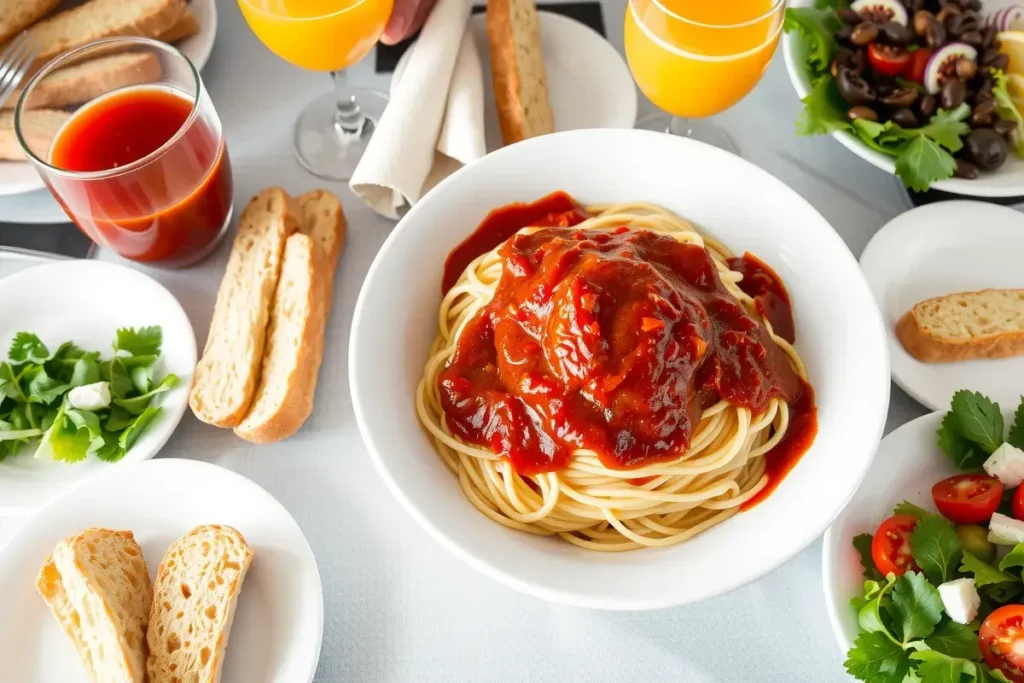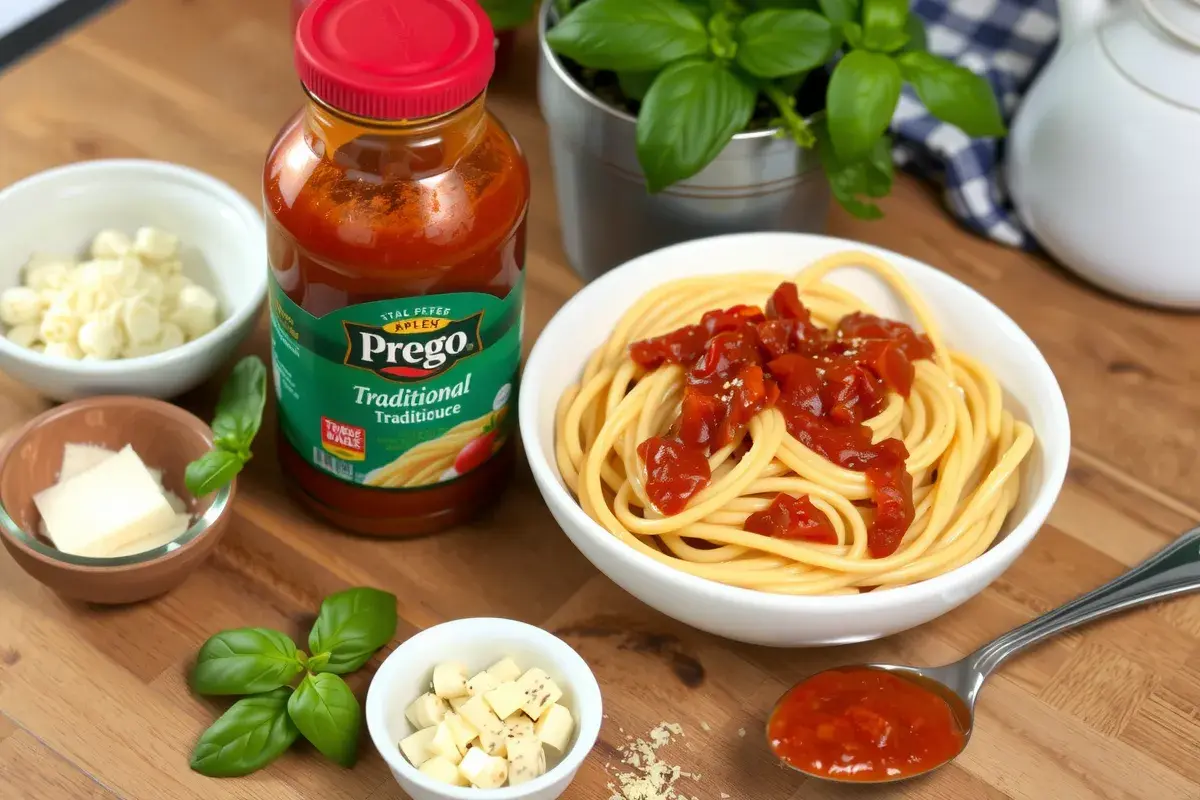Pasta is a beloved dish that unites households worldwide. Prego sauce has long been a popular favorite for those seeking a delicious, convenient way to upgrade any plate of spaghetti or penne. This tomato-based pasta sauce is more than just a jar of crushed tomatoes: it’s a culinary staple that can bring depth, flavor, and consistency to a wide range of meals.
Throughout this in-depth article, we will explore the history of Prego sauce, dissect its flavor profiles, discuss best practices for cooking, address nutritional values, and provide tips for using it in creative ways. We’ll also highlight common mistakes, share where to buy it, and tackle frequently asked questions. By the end, you’ll have all the knowledge needed to transform your everyday meals into remarkable feasts—simply by mastering the art of cooking with Prego sauce.
History of Prego Sauce
Few sauces can claim the global name recognition that Prego sauce commands today. However, it took dedicated research, testing, and consumer feedback for this product to become a household staple. The brand was introduced in the late 1970s by Campbell Soup Company. Before that time, many Americans relied on homemade sauce or limited-store-bought alternatives. Therefore, the emergence of Prego gave pasta lovers a stable, consistently tasty option.
The Birth of a Household Name
- Experimentation and Taste Tests: Campbell’s set out to create a pasta sauce that could rival family recipes. They spent countless hours perfecting the balance of tomatoes, herbs, spices, and oils.
- Consumer Adoption: Once the final formula was unveiled, families embraced the new sauce for its homemade taste and reliable quality. By continuously seeking feedback and refining new varieties, Prego expanded its range to meet different palates.
Evolving Over Time
Over the decades, Prego sauce has broadened its offerings to include flavors like Marinara, Italian Sausage & Garlic, Fresh Mushroom, and Alfredo (though Alfredo is not tomato-based). These variants cater to evolving consumer tastes. Today, you can find countless jarred versions of Prego that align with busy lifestyles yet maintain a sense of comfort and nostalgia.
Therefore, the brand’s successful evolution results from consistent product innovation, creative flavor adaptations, and robust market research. This dynamic approach has helped Prego sauce remain a top contender in a competitive spaghetti sauce market.
Why Choose Prego Sauce for Homemade Meals
Many people ask: “Why should I pick Prego sauce over other brands or even homemade concoctions?” The answer lies in its balance of taste, convenience, and reliability. While creating your own sauce from scratch can be fulfilling, it often demands time, fresh produce, and an understanding of seasoning proportions. Prego sauce, however, condenses that entire process into one jar, ensuring you always have a versatile base on hand.
Consistent Taste and Texture
One standout advantage of Prego sauce is consistency. For example, if you open a jar of Prego Traditional, you know exactly what flavor profile to expect—robust tomatoes, a mild sweetness, and a smooth consistency that clings wonderfully to pasta noodles.
Convenience Factor
It’s also worth noting that Prego sauce significantly reduces prep time. Instead of laboring over fresh tomatoes and spices for an hour or two, you can get dinner on the table in less than 30 minutes. Moreover, Prego sauce works well for last-minute dishes when unexpected guests arrive. Simply combine it with a cooked protein or vegetables, and you have a hearty meal in minutes.
Versatility in Dishes
Though traditionally used for pasta, Prego sauce pairs delightfully with other foods:
- Pizza: Spread it on homemade crusts.
- Casseroles: Combine it with chicken, cheese, and noodles for a warming comfort dish.
- Meatball Subs: Slather it on a roll with meatballs and Parmesan cheese.
- Eggplant Parmigiana: Layer it between breaded eggplant slices and mozzarella.
This adaptability is a huge plus for busy families and culinary enthusiasts looking to experiment.
Therefore, Prego sauce stands out among store-bought options because it offers consistency, convenience, and adaptability without compromising flavor.
Flavor Profiles and Variations of Prego Sauce
When scanning the supermarket shelves, you’ll notice many Prego sauce labels. This variety may be overwhelming initially, but each type caters to specific preferences—whether you crave something sweet, spicy, robust, or chunky. By understanding what each version offers, you can make a choice that aligns precisely with your palate.
Traditional Prego Sauce
- Flavor: Tangy and slightly sweet, with a prominent tomato presence.
- Best For: Classic spaghetti dinners, meatball subs, or as a base for a homemade chili.
Prego Marinara
- Flavor: A more straightforward tomato taste with fewer seasonings.
- Best For: Eggplant Parmesan, pizza sauce, or paired with sautéed onions and peppers for a chunky topping.
Chunky Garden Variants
- Flavor: Includes larger vegetable pieces like peppers, onions, and mushrooms.
- Best For: Quick vegetable-forward pasta dishes or a hearty topping for grilled chicken.
Prego Flavored with Meat
- Flavor: Infused with meat flavors, typically ground beef or sausage for added richness.
- Best For: Quick Bolognese-style meals, layered lasagna, or stuffed shells.
Specialty Varieties
Beyond the classics, Prego sauce boasts other variants, such as Creamy Vodka Sauce, Alfredo Sauce, and even Lower-Sodium or Lower-Fat versions. These are perfect for individuals with dietary restrictions or those who prefer specific flavor notes. For example, if you’re counting calories, you can choose the Light Smart or Heart Smart line to maintain a healthier meal plan without sacrificing taste.
Consequently, having a range of Prego sauces makes it easier to cater to different dietary preferences and gustatory experiences. Rather than adjusting your entire recipe, you can select the sauce variant that suits your taste.
Nutritional Benefits of Prego Sauce
While convenience often comes at the cost of nutrition, Prego sauce strives to balance flavor with health considerations. Nevertheless, reading nutrition labels is always advisable, especially for those following strict diets. Let’s discuss the core health components of these sauces to see how they can fit into your daily meal planning.
Key Nutrients
- Tomatoes: A primary ingredient in Prego sauce, tomatoes are high in vitamins C and A. They also contain lycopene, an antioxidant that may benefit heart health.
- Olive Oil (depending on variety): Provides healthy fats that help with nutrient absorption.
- Herbs and Spices: Ingredients like basil, oregano, and garlic not only add taste but also contain antioxidants that promote overall wellness.
Low-Fat Options
If reducing fat intake is a priority, consider Prego’s Light Smart options. They maintain much of the flavor of the standard versions yet reduce fat and calories. By doing so, these varieties help individuals manage weight or cardiovascular health more effectively.
Sodium Content
One common concern about jarred pasta sauces is their salt content. Prego sauce typically contains moderate sodium levels, but some lines, like the Heart Smart or Reduced Sodium, aim to address this issue. Therefore, you can still enjoy the convenience of jarred sauce without drastically exceeding your daily sodium limits.
Additional Tips
- Add Fresh Vegetables: Enhance the sauce’s nutritional profile by mixing in chopped zucchini, spinach, or carrots.
- Use Lean Proteins: If you plan to add ground meat, opt for ground turkey or chicken to keep saturated fat low.
- Pair with Whole-Grain Pasta: Whole-wheat noodles or other whole-grain options boost fiber intake, providing a more balanced meal.
For maximum health benefits, look for variants that suit your specific dietary needs. Most importantly, read labels carefully to ensure you’re selecting the best version of Prego sauce for you and your family.
Cooking Techniques with Prego Sauce

Mastering cooking techniques can take your Prego sauce dishes from ordinary to extraordinary. Although jarred sauces are typically heated and served, employing some culinary strategies can amplify flavors and textures significantly.
Sauté Aromatics First
Transition words like initially and therefore help guide us through this process. Initially, start by sautéing aromatics like minced garlic, diced onions, or bell peppers in a bit of oil. Doing so helps draw out their natural flavors. Therefore, when you add the jar of Prego sauce, the aromatic base infuses the entire dish.
Deglaze the Pan
When cooking proteins like beef or chicken, brown them in a skillet. Then, use a bit of wine, broth, or even water to deglaze the pan. This step ensures that the flavorful brown bits stuck to the pan incorporate into the sauce, resulting in a richer, deeper taste.
Simmer for Enhanced Flavor
Although you can warm Prego sauce in just a few minutes, letting it simmer on low heat for 20 to 30 minutes can deepen the flavor. During simmering, stir occasionally to prevent scorching. This extra time allows the herbs and spices to meld thoroughly with the tomatoes.
Layer Your Ingredients
When assembling lasagna or other baked pasta dishes, layer your ingredients thoughtfully. For instance, spoon a thin layer of Prego sauce at the bottom of the baking dish before adding noodles. Then, alternate between sauce, cheese, and fillings. This layering approach locks moisture in the pasta, ensuring an evenly cooked meal.
Stir in Fresh Herbs at the End
To preserve their vibrant taste and color, add fresh herbs like basil, parsley, or thyme just before serving. Doing so brightens the sauce, providing an inviting appearance and an aromatic boost.
By applying these cooking techniques, you can transform even the simplest pasta meal into a gourmet experience. However, remember to taste frequently and adjust seasonings such as salt, pepper, and red pepper flakes to meet your personal preference.
Prego Sauce Pairings Beyond Pasta
While Prego sauce is synonymous with spaghetti, it has significant potential beyond the classic noodle bowl. Indeed, thinking outside the culinary box can elevate your weekly menu.
Pizza and Flatbreads
Pizza night gets simpler when you use Prego sauce as the base. Spread a generous layer over store-bought dough or a flatbread, top with mozzarella and your favorite ingredients, and bake until the crust is golden. However, consider brushing the crust edges with olive oil for an extra-crisp finish.
Soup and Stew Base
If you’re short on ideas for a hearty soup, add a cup or two of Prego sauce to your vegetable or chicken broth. The tomato base thickens the stew, and the sauce’s herbs infuse a comforting Italian essence. Add vegetables, legumes, or small pasta shapes to create a filling meal.
Dips and Spreads
For an interesting party dip, mix Prego sauce with cream cheese and shredded mozzarella. Heat until bubbly, and serve with toasted baguette slices. This dip tastes similar to a warm, cheesy pizza in a bowl—perfect for social gatherings or game days.
Meat and Seafood
Use Prego sauce to marinate or bake proteins. For instance, bake chicken breasts in a casserole dish with layers of sauce and cheese for a Chicken Parmigiana-inspired meal. You can also simmer shrimp in a pan of Prego sauce with a dash of white wine for a quick spin on Cioppino.
Therefore, incorporating Prego sauce in recipes outside pasta fosters creativity and ensures you get your money’s worth from each jar. With minimal effort, you can fashion myriad dishes that still highlight this sauce’s signature taste.
Common Mistakes to Avoid When Using Prego Sauce

Even though Prego sauce offers convenience, certain pitfalls might undermine the final result. However, steering clear of these mistakes helps you utilize the sauce to its fullest potential.
Overcooking the Sauce
Simmering Prego sauce can enhance its flavor, but excessive heat or cooking time may cause the sauce to become too thick or lose some of its bright tomato notes. Aim for a gentle simmer rather than a rolling boil.
Not Adjusting Seasonings
Store-bought sauces are often designed to appeal to a broad audience. Therefore, Prego sauce might lack the exact intensity you desire, whether that’s more heat, sweetness, or herbaceousness. Don’t be afraid to add a pinch of sugar to balance acidity or sprinkle in chili flakes for extra spice.
Neglecting Fresh Ingredients
If you rely solely on jarred sauce, your dish might taste a bit one-dimensional. Incorporating fresh vegetables, herbs, or cheeses can elevate the overall complexity. For instance, sautéed mushrooms and bell peppers add both nutrition and texture.
Using It Straight from the Jar
While Prego sauce is ready to eat, heating it properly is essential. Using it cold or lukewarm over cooked pasta compromises the meal’s flavors. Warm your sauce thoroughly so it melds seamlessly with your noodles or other components.
Not Storing the Sauce Correctly
After opening a jar of Prego sauce, store it in the refrigerator, sealed tightly, and use it within a week to maintain freshness. If you don’t plan to use the entire jar soon, consider dividing it into portions and freezing for future meals. This method cuts waste and ensures you always have sauce on hand.
By avoiding these missteps, you can consistently produce flavorful, balanced dishes. Consequently, your experience with Prego sauce becomes far more enjoyable, maximizing both your time and your taste buds’ satisfaction.
From Market Shelves to Your Plate: Where to Find Prego Sauce
With global demand for Prego sauce at an all-time high, finding a jar is rarely a problem. In most areas, you’ll come across several variants in the condiments aisle of major grocery stores. However, depending on local inventory, some specialty or premium flavors might be less common.
Grocery Stores and Supermarkets
Big-chain supermarkets typically carry a wide range of Prego options, from the Traditional flavor to Chunky Garden Harvest. You can also find low-sodium and fat-free versions. Moreover, many stores frequently offer promotions or bulk-buy discounts on these products, making it economical to stock up.
Online Shopping
If you can’t find your preferred variant in brick-and-mortar establishments, online retailers are your next best bet. Amazon, Walmart, and other digital grocery services often have extensive product lines. Therefore, you have the freedom to compare prices and read reviews before finalizing your purchase.
Specialty Food Stores
Occasionally, gourmet shops will carry unique or small-batch flavors from the Prego brand. Such stores might also offer organic or region-specific varieties. For example, you might discover limited-edition Tomato Basil Garlic or a variant made with artisanal cheeses.
Farmers’ Markets (Rare)
While farmers’ markets typically focus on fresh produce, some vendors may stock jarred sauces. These might not always be official Prego products, but if they are, it can be a fun way to experiment with local twists on the brand. Nonetheless, this is less common, so rely on established grocery networks if you need a consistent supply.
In conclusion, the ubiquity of Prego sauce ensures you can easily incorporate it into your meals. Whether you’re shopping in person or online, a jar of your favorite flavor is usually within reach.
Frequently Asked Questions About Prego Sauce
Below are some of the top questions people ask about Prego sauce. By delving into these queries, you can broaden your understanding and refine your culinary techniques.
What is Prego sauce made of?
Prego sauce typically includes tomatoes, tomato puree, onions, garlic, salt, sugar, and a blend of herbs like oregano and basil. Some varieties also include additional ingredients like peppers or mushrooms. The brand carefully balances spices and other seasonings to create a robust, slightly sweet flavor profile.
What’s the difference between ragu and Prego sauce?
While both Ragu and Prego produce tomato-based pasta sauces, they differ in sweetness, thickness, and seasoning profiles. Prego sauce often has a thicker consistency and a slightly sweeter taste, whereas Ragu tends to be lighter in texture and may lean toward a more savory, herb-focused flavor. Ultimately, preference depends on personal taste and the type of dish you’re preparing.
Is Prego sauce healthy?
Prego sauce can be part of a healthy diet, particularly if you select the lower-sodium or lower-fat versions. Tomatoes provide antioxidants and vitamins, and the sauce contains herbs with potential health benefits. However, always check the nutrition label for specific sodium and sugar levels. For a healthier meal, consider pairing it with lean proteins and whole-grain pasta.
How do you make Prego sauce taste better?
To enhance Prego sauce, try sautéing fresh aromatics—like onions, garlic, and bell peppers—before adding the jarred sauce. You can also:
- Simmer with a splash of red wine or broth.
- Add a pinch of sugar to balance acidity.
- Throw in chili flakes for spice or dried Italian herbs for extra complexity.
- Top your dish with fresh basil and grated Parmesan cheese.
Conclusion
Prego sauce has cemented its place in modern kitchens around the globe. Its reliable flavor, versatile usage, and straightforward preparation make it an ideal companion for busy weeknights, large family gatherings, and even experimental cooking endeavors. By choosing a variety that aligns with your dietary needs and taste preferences, you can harness the convenience of jarred pasta sauce without sacrificing quality. Moreover, mastering basic cooking techniques—like sautéing aromatics, deglazing the pan, and adding fresh ingredients—will elevate your Prego-based dishes to restaurant-level flavors.
Therefore, whether you’re simmering a pot of spaghetti on a chilly evening or crafting a bold new casserole creation, Prego sauce offers an appealing foundation. With its extensive range of flavors and product lines, there’s truly a Prego option for everyone. So, enjoy discovering fresh, innovative ways to incorporate this much-loved sauce into your culinary repertoire, and relish every spoonful of savory, comforting taste.

